All dog breeds, from the tiniest Chihuahua to the colossal Great Dane, originate from the wolf. Wolves (Canis Lupus) are majestic creatures that many cultures revere for their mysterious character and high intelligence.
Wolves have piercing eyes that feel like they reach deep into your soul when you look at them. And yet, these hunters make you a little afraid because you know the raw power they possess.
We compiled a complete list of the most common foods that wolves around the world eat. You’ll be surprised by some of the foods they consume.
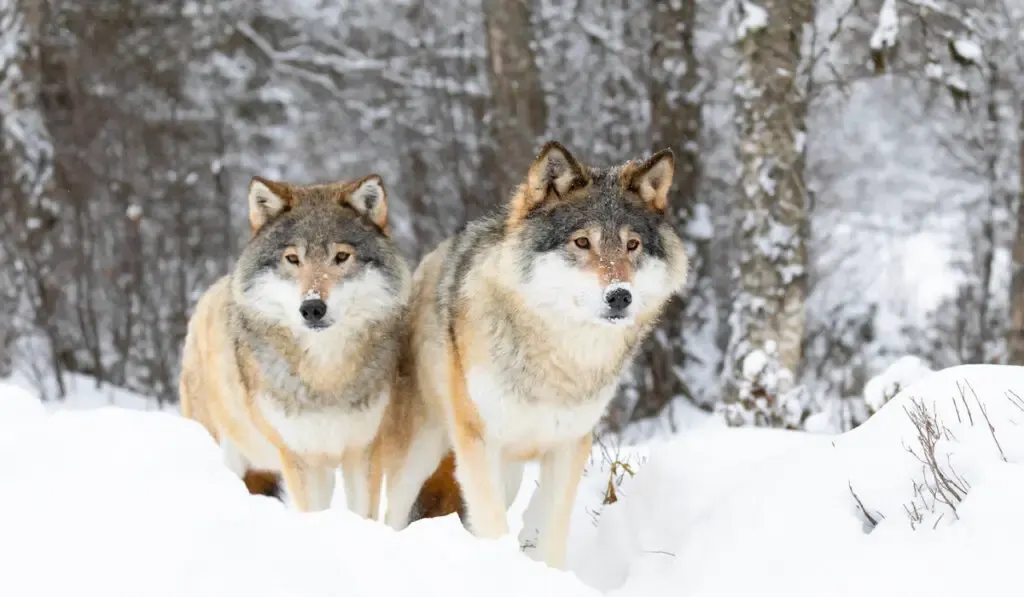
Table of Contents
Understanding the Habitat and Eating Habits of the Wolf
The gray wolf (Canis Lupus) and red wolf (Canis Rufus) are the only two wolf species that researchers recognize. Some question whether Ethiopian or Abyssinian wolves are actually jackals. You’ll find many subspecies of wolves around the world.
Wolves evolved to withstand the harshest environments, surviving alone or in packs. A wolf’s diet changes with the seasons. Other factors influence what they eat, but most have a similar diet no matter where you find them.
What is the Natural Habitat of Wolves?
The best way to describe a wolf is as a ‘habitat generalist’. They quickly adapt to any environment, so they can essentially live anywhere. Many people believe wolves only live in colder climates, but they can withstand temperatures that range from -70°F to 120°F.
Wolves live around the world, including:
- North America
- Europe
- Asia
- North Africa
Gray wolves like to live in remote locations like plains, forests, tundras, and taigas, depending on the continent.
They don’t usually live in high, mountainous areas, but some breeds do, like the Iberian and North American wolves. African wolves adapt to living in arid environments and tend to live in rocky places at the borders of deserts.
Gray wolves from India prefer to live on the plains or in jungles, while arctic wolves love the cool air of the tundra.
Red wolves prefer to be near swamps or in grasslands. Today, you can only find them in protected areas. By 1980, wild red wolves were extinct. They are on the IUCN Red List now because scientists reintroduced the species.
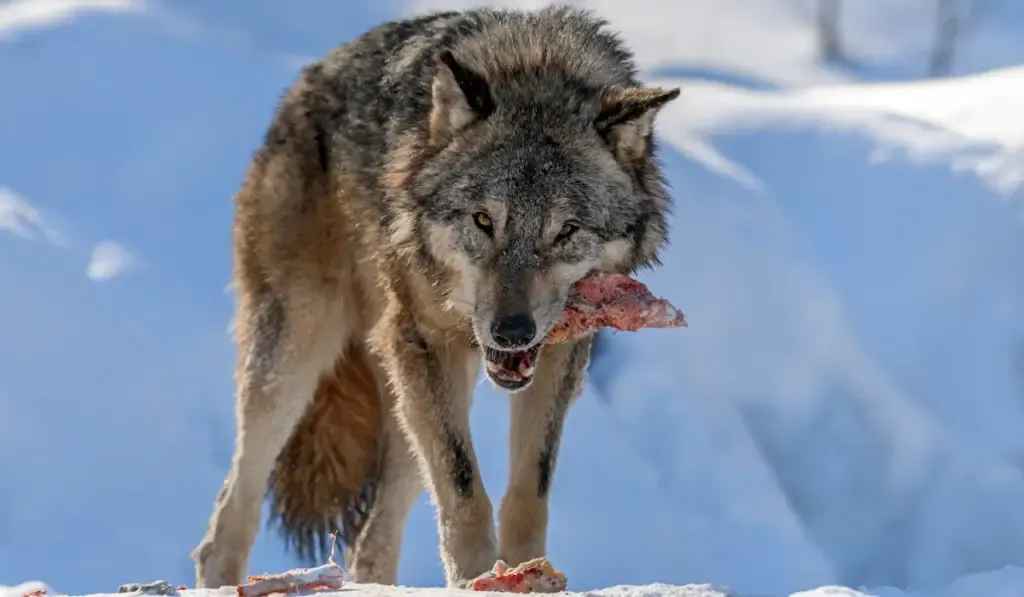
What Influences Their Diet?
Wolves are highly adaptable animals. They can live in severe conditions and will find something to eat no matter where they live.
Many factors influence their diets, including:
- Habitat – The environment around them impacts what they eat. Wolves that live in forests will eat more deer than those that live in swamps.
- Season – The availability of food largely depends on the seasons, so a wolf will adapt its diet accordingly. Although wolves are predominantly hunters, they will scavenge during seasons like winter when food choices are slim.
- Travel – Wolves are hunters and will travel over 50 miles a day to locate prey. The elbows on their legs turn inward, giving them perfect balance, so roaming is easy for them. Some wolves travel hundreds of miles in emergencies or when searching for a lost member of the pack.
- Territory – Wolves have their own territories, and the size usually depends on how much prey is available. Territories are around 25 – 30 square miles in areas where food is scarce and about 80 – 90 square miles if there is plenty of prey.
- Humans – Wolves will eat livestock from farms or homes that are in or near their territory, especially in months with little food.
Most wolves have a similar diet with minor variations because of the above factors.
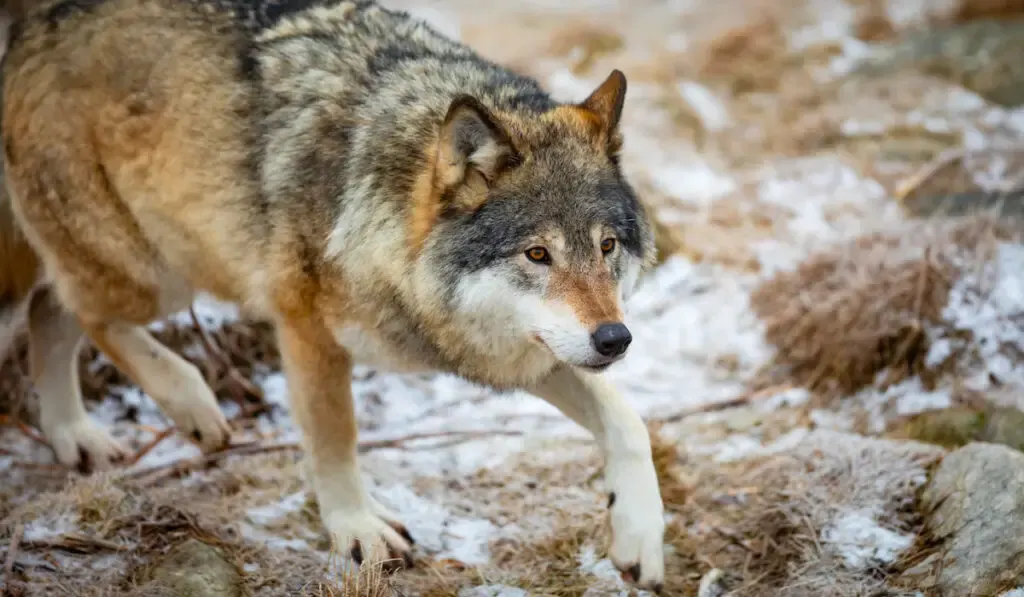
How Do They Catch Their Prey?
Wolves begin their hunt with a tribal howling session. They do this to scare off any other wolves that wander into their territory.
Once the pack establishes its dominance, they fan out in search of prey. Wolves move in the opposite direction of the wind to avoid detection. They slowly approach, and when the time is right, they make their move.
Wolves will chase their prey, biting the rump and sides. They then kill the animal by biting the snout or throat.
Packs work together to take down large animals like bison and moose. They will hunt alone when catching smaller prey or if they are lost.
Interestingly, wolves have a hierarchy within their packs. Along with being able to chase off other suitors, alpha males get first pickings of whatever food is brought back after a hunt. The alpha female does the same.
How Much Do Wolves Eat?
Gray wolves need five to seven pounds of food a day to stay healthy and can survive on two and a half pounds if necessary. Alpha wolves can eat about 22 pounds of food at one time.
When food is scarce, wolves can survive for days or even weeks without eating anything. Wolf pups can’t manage that long without sustenance.
Red wolves require less food and eat between two to five pounds per day. They eat less in a single hunt because they are smaller than gray wolves.
Foods Commonly Eaten by Wolves
A wolf’s diet depends on its habitat and the season. It consists of around 60% meat and 40% plants. That’s right, wolves also need their fruits and vegetables to stay strong and healthy.
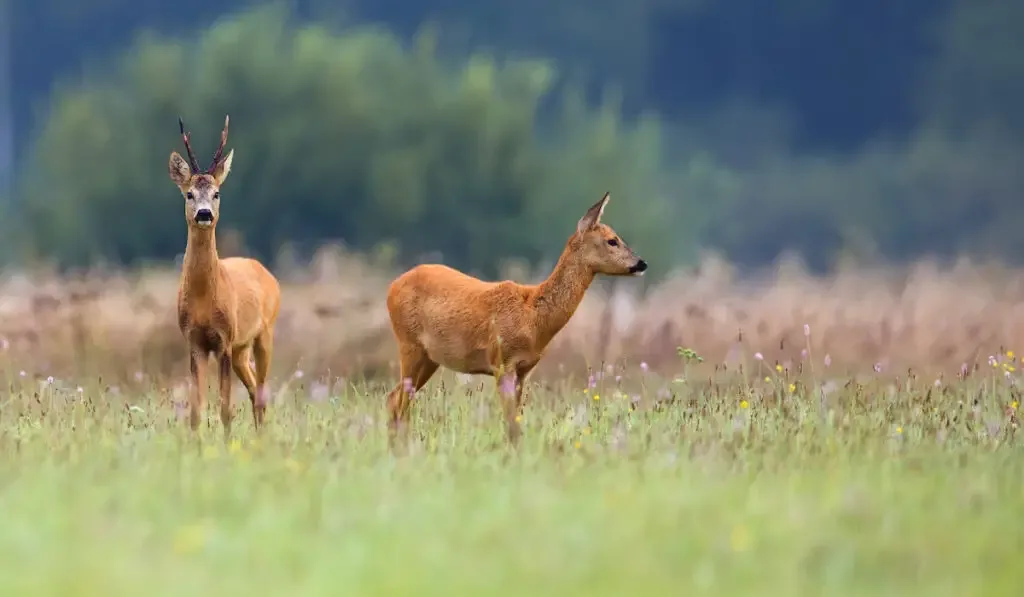
1. Deer
Both gray and red wolves eat deer. These brown-furred prey stand out against the white snow, making them easy targets for hungry wolves during winter.
Deer live on all continents except Australia and Antarctica. Some live in forests while others live in swamps.
Many consider deer pests because their populations filter into urban life. Wolves help manage the herds. In fact, some researchers estimate that wolves kill around 45,000 to 57,000 deer a year in the U.S.
2. Salmon
Wolves don’t hibernate during the winter. When fall comes around, they do their best to fatten up.
These wild canines will catch salmon during fall to conserve energy. After all, catching fish is a lot easier than chasing down a giant ox. It also reduces the risk of injuries, which use energy to heal.
Salmon also has excellent nutritional value and high-fat content. Wolves will gain weight to keep them sturdy when food becomes scarce in winter.
3. Hares
Hares are common in the diet of both grey and red wolves. Snowshoe and whitetail hares are easier to catch during spring and summer but easily merge with the white of winter.
Wolves will catch hares alone for a quick and easy snack.
4. Beavers
Gray and red wolves that make their territories near lakes and dams will often feed on beavers. They are easy to catch and make a heartier meal than hares or squirrels.
Beavers make up about 25-75% of a wolf’s diet during spring.
5. Mice and Rats
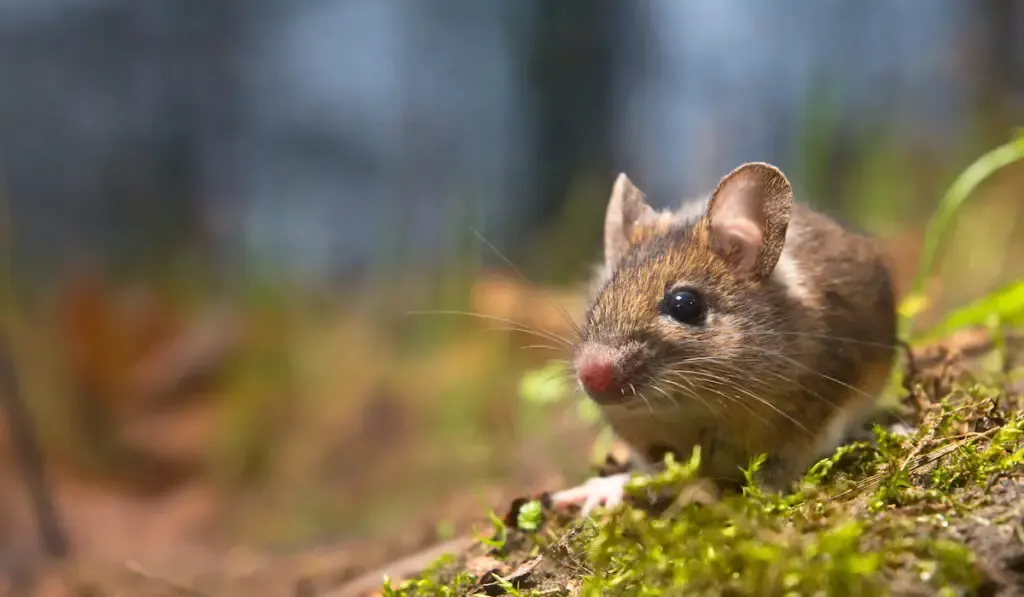
In winter, wolves struggle to find food. They will catch and eat whatever they can get their paws on, including mice and rats.
Of course, this does not provide enough food for them but helps satisfy some of their hunger pains when food is scarce.
Wolves will also catch and eat these rodents during spring and summer if they want a quick snack.
6. Moose
The mighty moose called an elk in British English is the largest subspecies of red deer. Their magnificent antlers leave us in awe but are a real threat to wolves.
When hunting moose, the pack will attack from the side or back to avoid a stabbing. Like with other deer, moose are a favorite for wolves because they provide a lot of meat.
7. Bison
Today, only two species of bison exist, namely the North American and European bison. These large animals make an excellent meal for wolves because they provide so much food.
Wolves hunt bison mostly in summer. Bison have big heads that they use as battering rams, so wolves hunt from the side to avoid being hit head-on.
8. Caribou
Another subspecies of deer, the caribou or reindeer, is a favorite among wolves. They provide plenty of meat during spring and summer.
Caribou commonly live in snowy regions. Gray and red wolves that live in tundras are most likely to eat these animals.
9. Pocket Gophers
Pocket gophers are a pest to most farmers, so it might please you to see this one on the list. These sneaky creatures love to burrow underground, making intricate tunnels that often destroy gardens.
Wolves catch pocket gophers during spring and summer when food is plentiful to help them gain weight for winter.
10. Musk Ox
The musk ox is native to the Arctic circle and is massive like bison. Wolves use a lot of energy catching and killing these animals, so they hunt them in spring or summer.
The musk ox moves slowly but has a gigantic head to protect it from predators. Wolves must carefully calculate their attack to avoid injury.
11. Fruits
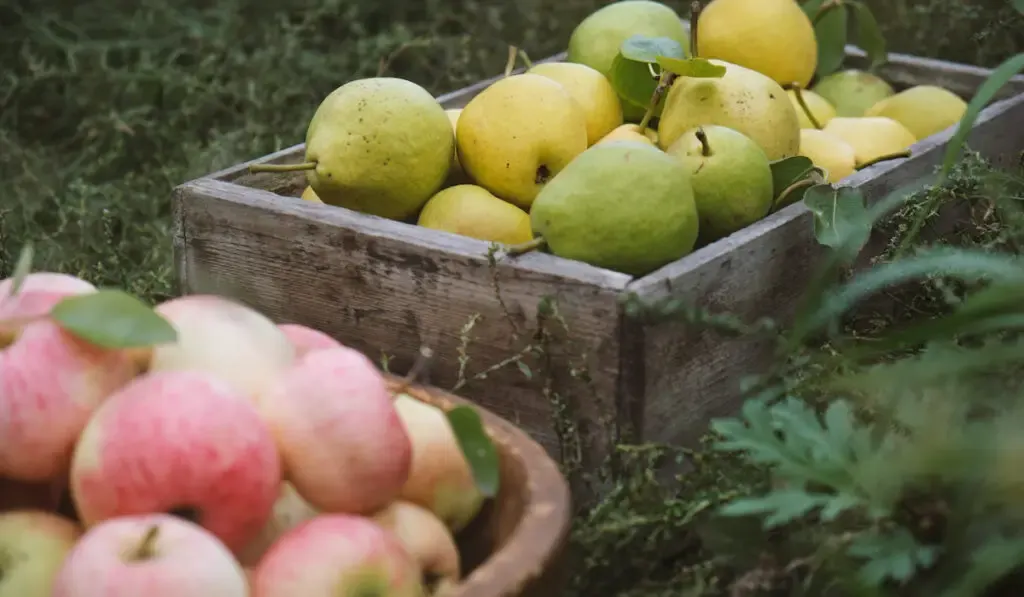
Spring brings an abundance of wild fruits like blueberries, chokeberries, and strawberries.
Wolves love to munch on these delicious fruits and will also eat apples and pears if they can find the trees.
Many speculate that wolves eat fruits to replenish nutrients lost in the colder months and help gain weight for the coming winter. Others say these canines simply like the sweet, juicy taste.
12. Vegetables
Wolves eat vegetables during spring and summer. Like with fruits, many people are divided on the reasons for eating these plants.
Wolves, like dogs and cats, will eat grasses when they have an upset tummy. It’s a trait most carnivorous animals inherited from their ancestors to help with digestion.
13. Squirrels
Squirrels are a favorite snack among wolves. They commonly eat these little critters during spring and summer when trying to fatten up for winter.
Squirrels are rodents, and their family tree includes chipmunks, marmots, and prairie dogs. Wolves will eat them all.
14. Birds
Wolves don’t always eat birds but will during spring and summer in preparation for breeding and winter.
The type of birds they eat will depend on where they live. Red wolves that live near swamps or estuaries in North America eat herons and egrets.
Gray wolves that live in the grasslands of India prey on hornbills and weavers.
15. Reptiles
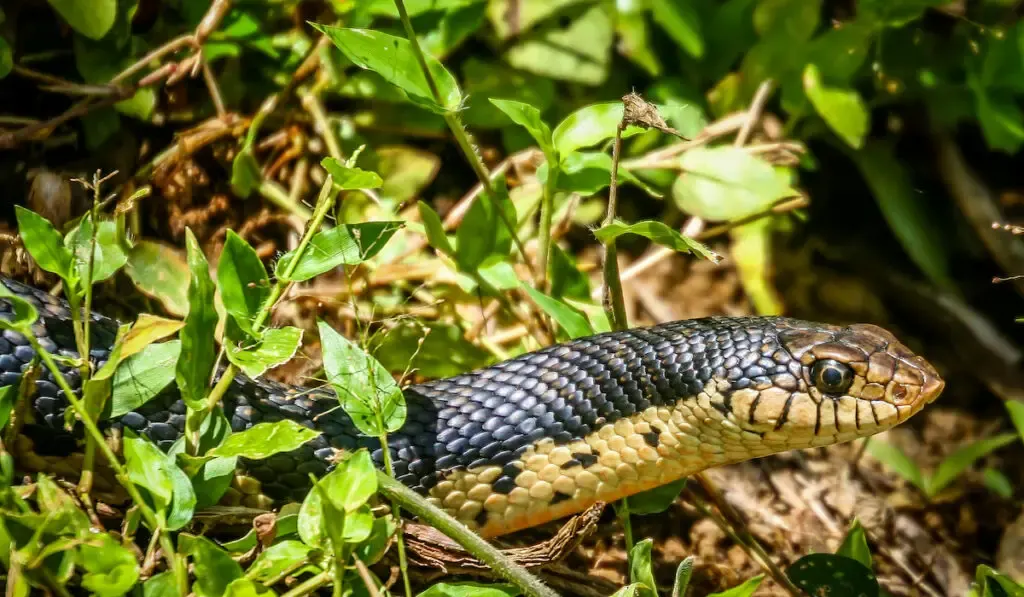
Spring is the best time of the year for wolves. They truly eat anything they can find, trying to make up for all the lost time in winter.
Wolves will eat most reptiles, including snakes and lizards. They might grab one as a snack as their pack moves through their territory, searching for more substantial food.
16. Insects
Another fantastic high-protein snack on the list, wolves eat insects as they wander through their territory.
They don’t hunt for insects but catch them as they go. During winter, wolves might dig in the earth for hibernating bugs if food is scarce.
17. Amphibians
Wolves eat amphibians like frogs and toads during autumn when food is becoming scarce.
Red wolves eat more amphibians than gray wolves simply because they usually live in swamps or near water.
18. Marmots
Marmots are sizable ground squirrels that live in mountainous or rocky areas. They come from Asia, Europe, and North America.
Wolves eat marmots in summer because that’s when the little critters are active. They hibernate during winter, unlike wolves.
19. Weasels
Weasels are from the genus Mustela that also includes polecats, ferrets, and mink. They are carnivores that mostly eat insects.
Wolves catch weasels in spring and summer to fatten up after a sparse winter and prepare for breeding.
20. Livestock
When a wolf’s territory overlaps with farmlands, it will often eat whatever livestock is available, including cows, sheep, and goats.
Wolves have a complicated history with farmers, and almost went because people saw them as a threat to their livelihoods.
They usually eat farm animals when there is little food available in the wild. Wolves will also hunt livestock in autumn to minimize energy spent searching for and catching prey.
21. Voles
Voles are adorable and are close relatives to lemmings and hamsters. Wolves eat voles during spring and summer.
Gray and red wolves that live in the plains, meadows, or grasslands commonly eat voles.
22. Raccoons
Indian gray wolves love eating raccoons, but they aren’t the only ones. Raccoons are relatively easy for a wolf to catch.
They are a great alternative to beavers. Wolves eat them in summer and autumn to fatten up for the winter.
23. Rabbits
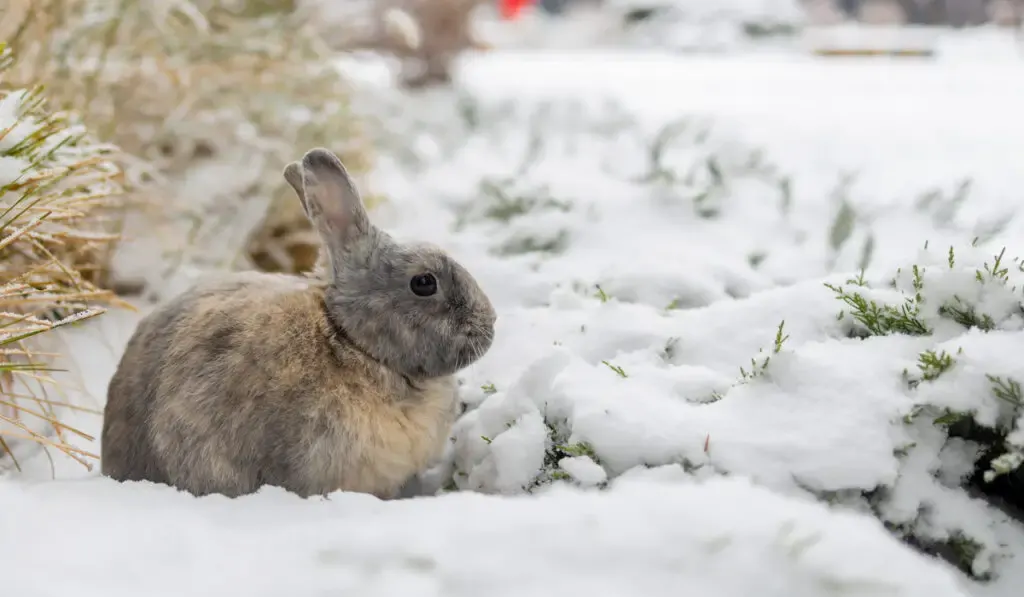
Rabbits are a favorite among almost all carnivores big enough to eat them. Wolves catch rabbits all year round, but mostly in spring and summer when there is plenty of food.
Rabbits can be a pest because of their rapid gestation period. Wolves can help minimize overpopulation.
24. Grey Langurs
These monkeys are only found in Asia and Africa. People call them Old World Monkeys.
Wolves from these continents commonly eat grey langurs in summer.
25. Mountain Goats
Grey wolves that live in mountainous areas love to hunt mountain goats. They have a well-balanced meat-to-fat ratio.
Wolves hunt mountain goats in the summer.
Final Thoughts
Wolves predominantly eat meat but also consume fruits and vegetables in spring and summer. They eat grasses when their gut doesn’t feel healthy.
Wolves eat almost any animal or insect. Their diet varies depending on habitat, territory, and season. They usually hunt in packs but will catch smaller prey when alone.
RESEARCH
- https://www.nwf.org/Educational-Resources/Wildlife-Guide/Mammals/Gray-Wolf
- https://rangerplanet.com/what-do-wolves-eat-complete-list-of-what-a-wolf-preys-on/
- https://animalsanswers.com/what-do-gray-wolves-eat/
- https://wolf.org/wolf-info/basic-wolf-info/wolf-faqs/#toggle-id-18
- https://animalcorner.org/animals/wolves/
- https://northamericannature.com/what-do-wolves-eat/
- https://www.livescience.com/27909-wolves.html
- https://feedingnature.com/what-do-wolves-eat/
